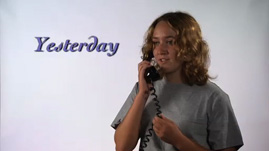Teachers' Domain - Digital Media for the Classroom and Professional Development
User: Preview



This brief video from WPSU compares technologies from yesterday with today. Yesterday a middle school girl would have called her mom on a phone while today a girl the same age video chats on her computer. The video suggests that science will bring us technologies of tomorrow.
Brainstorm ten objects that you use on a regular basis that your parents did not have when they were your age. Predict differences that may be seen within the next ten years for technology-based devices. Discuss how science and technology have transformed the way we communicate, are entertained and find out information.
Most elementary and middle school students harbor misconceptions about just what a scientist, technologist, engineer, mathematician (STEM) or other STEM related career person is like. A scientist is likely a white male with a lab coat and facial hair, according to a 1997 study of over 1500 students from 23 states, the District of Columbia and three other countries. Teachers can shatter this stereotype and address the lack of women and other traditionally underrepresented groups by serving as a source of career information about STEM fields. Information about STEM careers is offered by the Department of Labor, National Institutes of Health, American Medical Association, Vocational Information Center, NASA, and NOAA.
The time to foster a budding interest in choosing STEM careers is during middle and high school. A survey of STEM practitioners found that over a quarter of respondents started thinking about a career in STEM before the age of 11 and a further third between the ages of 12-14. Often, these interests fade in the face of significant obstacles. In addition to stereotypes of what STEM practitioners are like, and a lack of available career information, students enthusiastic about STEM careers must overcome a general dislike of traditional lecture-based math and science coursework that begins in upper elementary grades and continues through secondary education.
Students in middle and high school are often drawn to highly visible professions in the entertainment and sports fields, though their chances of a landing a job in these fields at an income level that can sustain them are very slim. Teachers can help put pursuit of entertainment and sports careers in perspective by encouraging students to research facts about these fields in contrast to STEM occupations.
The Department of Labor’s Occupational Outlook Handbook lists the following significant points for actors: long periods of unemployment, intense competition for roles, and frequent rejections in auditions. Earnings can be erratic, forcing many actors to supplement their income with jobs in other fields. Very few actors become highly successful with extraordinarily high earnings.
The NFL reports that 215 of the 100,000 high school seniors who play football (0.2%) will ever make an NFL roster; 40 of 5,000,000 or 0.00008% of high school boys playing basketball will become an NBA basketball player.
Given these odds, students may want to consider the following. Is it more likely that a classmate will become a pro athlete or television or movie star, or that he or she will become a scientist, technologist, engineer or mathematician who helps work on a new technology that will improve people’s lives?
To meet some graduate students who believe passionately in science, technology, engineering and math (STEM) careers, watch STEM Careers Grad Students.
To meet some middle school students dreaming of designing everything from awesome robots to solar cars, watch STEM Careers Middle School.
To compare yesterday's technologies with today's, check out this series of brief videos:
 Loading Standards
Loading Standards Teachers' Domain is proud to be a Pathways portal to the National Science Digital Library.
Teachers' Domain is proud to be a Pathways portal to the National Science Digital Library.
